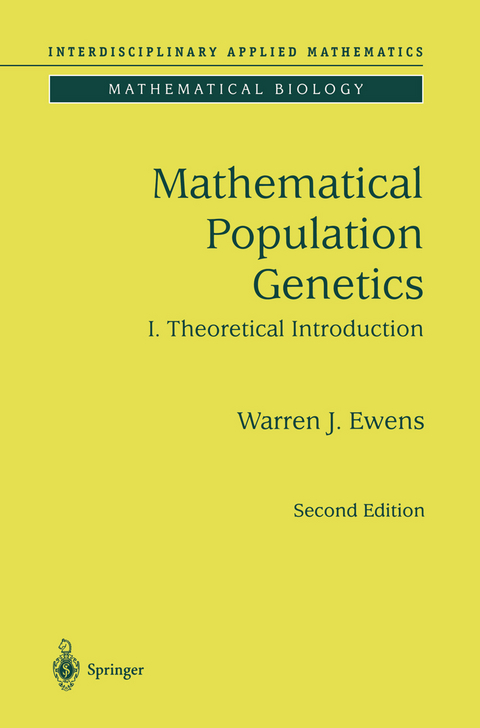
Mathematical Population Genetics 1
Springer-Verlag New York Inc.
978-1-4419-1898-7 (ISBN)
This is the first of a planned two-volume work discussing the mathematical aspects of population genetics, with an emphasis on the evolutionary theory. This first volume draws heavily from the author's classic 1979 edition, which appeared originally in Springer's Biomathematics series. It has been revised and expanded to include recent topics which follow naturally from the treatment in the earlier edition, e.g., the theory of molecular population genetics.
This book will appeal to graduate students and researchers in mathematical biology and other mathematically-trained scientists looking to enter the field of population genetics.
1 Historical Background.- 1.1 Biometricians, Saltationists and Mendelians.- 1.2 The Hardy-Weinberg Law.- 1.3 The Correlation Between Relatives.- 1.4 Evolution.- 1.5 Evolved Genetic Phenomena.- 1.6 Modelling.- 1.7 Overall Evolutionary Theories.- 2 Technicalities and Generalizations.- 2.1 Introduction.- 2.2 Random Union of Gametes.- 2.3 Dioecious Populations.- 2.4 Multiple Alleles.- 2.5 Frequency-Dependent Selection.- 2.6 Fertility Selection.- 2.7 Continuous-Time Models.- 2.8 Non-Random-Mating Populations.- 2.9 The Fundamental Theorem of Natural Selection.- 2.10 Two Loci.- 2.11 Genetic Loads.- 2.12 Finite Markov Chains.- 3 Discrete Stochastic Models.- 3.1 Introduction.- 3.2 Wright-Fisher Model: Two Alleles.- 3.3 The Cannings (Exchangeable) Model: Two Alleles.- 3.4 Moran Models: Two Alleles.- 3.5 K-Allele Wright-Fisher Models.- 3.6 Infinitely Many Alleles Models.- 3.7 The Effective Population Size.- 3.8 Frequency-Dependent Selection.- 3.9 Two Loci.- 4 Diffusion Theory.- 4.1 Introduction.- 4.2 The Forward and Backward Kolmogorov Equations.- 4.3 Fixation Probabilities.- 4.4 Absorption Time Properties.- 4.5 The Stationary Distribution.- 4.6 Conditional Processes.- 4.7 Diffusion Theory.- 4.8 Multi-dimensional Processes.- 4.9 Time Reversibility.- 4.10 Expectations of Functions of Diffusion Variables.- 5 Applications of Diffusion Theory.- 5.1 Introduction.- 5.2 No Selection or Mutation.- 5.3 Selection.- 5.4 Selection: Absorption Time Properties.- 5.5 One-Way Mutation.- 5.6 Two-Way Mutation.- 5.7 Diffusion Approximations and Boundary Conditions.- 5.8 Random Environments.- 5.9 Time-Reversal and Age Properties.- 5.10 Multi-Allele Diffusion Processes.- 6 Two Loci.- 6.1 Introduction.- 6.2 Evolutionary Properties of Mean Fitness.- 6.3 Equilibrium Points.- 6.4 Special Models.- 6.5 Modifier Theory.- 6.6 Two-Locus Diffusion Processes.- 6.7 Associative Overdominance and Hitchhiking.- 6.8 The Evolutionary Advantage of Recombination.- 6.9 Summary.- 7 Many Loci.- 7.1 Introduction.- 7.2 Notation.- 7.3 The Random Mating Case.- 7.4 Non-Random Mating.- 7.5 The Correlation Between Relatives.- 7.6 Summary.- 8 Further Considerations.- 8.1 Introduction.- 8.2 What is Fitness?.- 8.3 Sex Ratio.- 8.4 Geographical Structure.- 8.5 Age Structure.- 8.6 Ecological Considerations.- 8.7 Sociobiology.- 9 Molecular Population Genetics: Introduction.- 9.1 Introduction.- 9.2 Technical Comments.- 9.3 Infinitely Many Alleles Models: Population Properties..- 9.4 Infinitely Many Sites Models: Population Properties.- 9.5 Sample Properties of Infinitely Many Alleles Models..- 9.6 Sample Properties of Infinitely Many Sites Models.- 9.7 Relation Between Infinitely Many Alleles and Infinitely Many Sites Models.- 9.8 Genetic Variation Within and Between Populations.- 9.9 Age-Ordered Alleles: Frequencies and Ages.- 10 Looking Backward in Time: The Coalescent.- 10.1 Introduction.- 10.2 Competing Poisson and Geometric Processes.- 10.3 The Coalescent Process.- 10.4 The Coalescent and Its Relation to Evolutionary Genetic Models.- 10.5 Coalescent Calculations: Wright-Fisher Models.- 10.6 Coalescent Calculations: Exact Moran Model Results.- 10.7 General Comments.- 10.8 The Coalescent and Human Genetics.- 11 Looking Backward: Testing the Neutral Theory.- 11.1 Introduction.- 11.2 Testing in the Infinitely Many Alleles Models.- 11.3 Testing in the Infinitely Many Sites Models.- 12 Looking Backward in Time: Population and Species Comparisons.- 12.1 Introduction.- 12.2 Various Evolutionary Models.- 12.3 Some Implications.- 12.4 Statistical Procedures.- Appendix A: Eigenvalue Calculations.- References.- Author Index.
| Erscheint lt. Verlag | 29.11.2010 |
|---|---|
| Reihe/Serie | Interdisciplinary Applied Mathematics ; 27 |
| Zusatzinfo | XX, 418 p. |
| Verlagsort | New York, NY |
| Sprache | englisch |
| Maße | 155 x 235 mm |
| Themenwelt | Mathematik / Informatik ► Mathematik ► Angewandte Mathematik |
| Naturwissenschaften ► Biologie ► Biochemie | |
| Naturwissenschaften ► Biologie ► Evolution | |
| Naturwissenschaften ► Biologie ► Genetik / Molekularbiologie | |
| ISBN-10 | 1-4419-1898-1 / 1441918981 |
| ISBN-13 | 978-1-4419-1898-7 / 9781441918987 |
| Zustand | Neuware |
| Haben Sie eine Frage zum Produkt? |
aus dem Bereich


